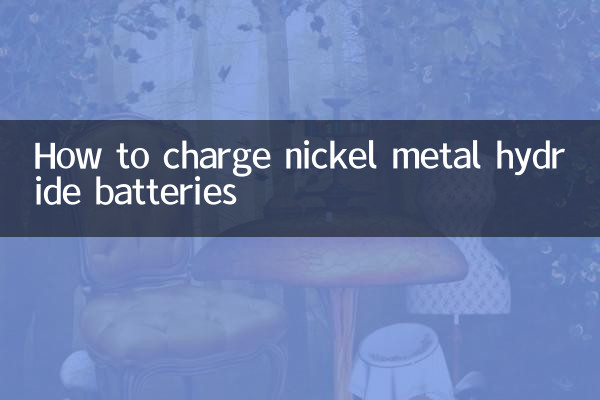How to charge nickel metal hydride batteries
With the improvement of environmental awareness and the development of new energy technology, nickel-metal hydride batteries are widely used in digital products, electric tools, hybrid vehicles and other fields due to their environmental protection, high energy density and long cycle life. However, proper charging method is crucial to extending battery life and ensuring performance. This article will introduce the charging method of nickel-metal hydride batteries in detail, and attach structured data for reference.
1. Basic principles of charging nickel-metal hydride batteries

Nickel metal hydride battery (NiMH) is a secondary battery that charges and discharges through the chemical reaction of nickel hydroxide positive electrode and hydrogen storage alloy negative electrode. When charging, the current converts electrical energy into chemical energy for storage; when discharging, the opposite is true. The following are the key parameters during its charging process:
| parameters | Typical value | Description |
|---|---|---|
| Charging voltage | 1.4-1.6V/section | Single battery full voltage |
| Charging current | 0.1C-1C | C is the battery capacity (for example, 1C=2A for a 2000mAh battery) |
| temperature range | 0℃-45℃ | Exceeding the range may damage the battery |
2. Charging method of nickel-metal hydride battery
1.Constant current charging: Charging to the end voltage with a fixed current, suitable for fast charging, but it needs to be equipped with temperature or voltage detection to prevent overcharging.
2.Trickle charging: Charging for a long time with a low current of 0.05C-0.1C, suitable for backup power supply, but may shorten battery life.
3.-ΔV detection charging: Determining full charge by detecting voltage drop is the method adopted by mainstream smart chargers.
| Charging method | Advantages | Disadvantages |
|---|---|---|
| Constant current charging | fast | Need to protect circuit |
| Trickle charging | Easy to operate | Easy to overcharge |
| -ΔV detection | High security | Requires special charger |
3. Charging precautions
1.Avoid overcharging: Overcharging will cause heating and electrolyte decomposition. It is recommended to use a charger with automatic power-off.
2.temperature control: Charging in a high-temperature environment will accelerate battery aging. If the battery is seriously overheated, charging should be suspended.
3.Periodically fully discharge: Ni-MH batteries have a "memory effect" and it is recommended to fully discharge them once a month to maintain capacity.
| question | solution |
|---|---|
| Battery capacity decreased | Recharge after deep discharge |
| Charger not recognized | Clean battery contacts or replace charger |
| Generates heat while charging | Reduce charging current or suspend charging |
4. Popular questions and answers
Q: Do new nickel-metal hydride batteries need to be activated?
A: No deliberate activation is required, and the best performance can be achieved by charging and discharging normally 2-3 times.
Q: Can nickel metal hydride batteries be used while charging?
A: Not recommended as it may cause battery overheating or circuit failure.
5. Summary
Proper charging is key to ensuring the performance and life of NiMH batteries. Choosing a smart charger, controlling the temperature of the charging environment, and performing regular maintenance can significantly extend the battery life. Choose fast charging or trickle charging according to actual needs, while avoiding overcharging and high temperature environments, so that your nickel-metal hydride batteries can perform at their best.

check the details

check the details